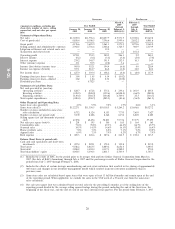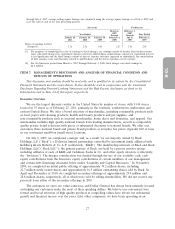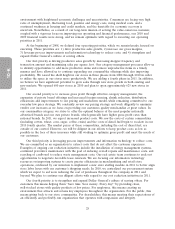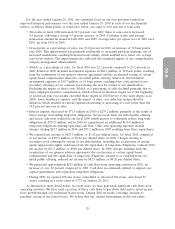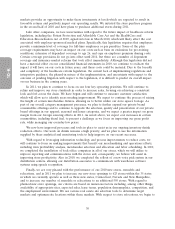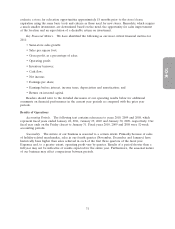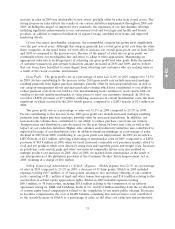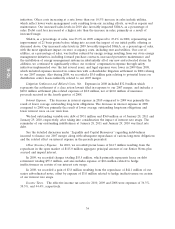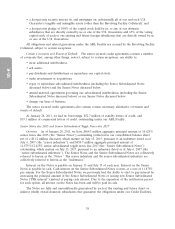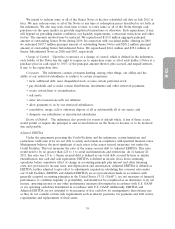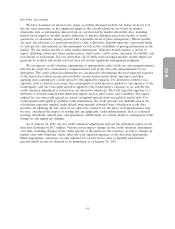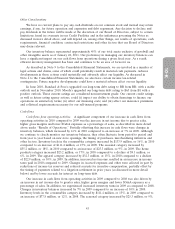Dollar General 2010 Annual Report Download - page 114
Download and view the complete annual report
Please find page 114 of the 2010 Dollar General annual report below. You can navigate through the pages in the report by either clicking on the pages listed below, or by using the keyword search tool below to find specific information within the annual report.
10-K
certain strategic decisions which slowed our store growth in 2007 and 2008, but we reaccelerated store
growth beginning in 2009 and currently plan to continue that strategy in 2011 and beyond.
At January 28, 2011, we had total outstanding debt (including the current portion of long-term
obligations) of $3.29 billion. We also had an additional $959.3 million available for borrowing under our
senior secured asset-based revolving credit facility (‘‘ABL Facility’’ and, together with the Term Loan
Facility, the ‘‘Credit Facilities’’) at that date. Our liquidity needs are significant, primarily due to our
debt service and other obligations. Our substantial debt could adversely affect our ability to raise
additional capital to fund our operations, limit our ability to react to changes in the economy or our
industry or to pursue our growth strategy, expose us to interest rate risk to the extent of our variable
rate debt, and increase the difficulty of our ability to make payments on our outstanding debt
securities.
Nevertheless, management believes our cash flow from operations and existing cash balances,
combined with availability under the Credit Facilities (described below), will provide sufficient liquidity
to fund our current obligations, projected working capital requirements and capital spending for a
period that includes the next twelve months and the next several years.
Credit Facilities
Overview. We have two senior secured credit facilities which provide financing of up to
$2.995 billion as of January 28, 2011. The Credit Facilities consist of the $1.964 billion Term Loan
Facility and the $1.031 billion ABL Facility (of which up to $350.0 million is available for letters of
credit), subject to borrowing base availability. The ABL Facility includes borrowing capacity available
for letters of credit and for short-term borrowings referred to as swingline loans.
The amount available under the ABL Facility (including letters of credit) shall not exceed the sum
of the tranche A borrowing base and the tranche A-1 borrowing base. The tranche A borrowing base
equals the sum of (i) 85% of the net orderly liquidation value of all our eligible inventory and that of
each guarantor thereunder and (ii) 90% of all our accounts receivable and credit/debit card receivables
and that of each guarantor thereunder, in each case, subject to customary reserves and eligibility
criteria. An additional 10% of the net orderly liquidation value of all of our eligible inventory and that
of each guarantor thereunder is made available to us in the form of a ‘‘last out’’ tranche under which
we may borrow up to a maximum amount of $101.0 million. Borrowings under the ABL Facility will be
incurred first under the last out tranche, and no borrowings will be permitted under any other tranche
until the last out tranche is fully utilized. Repayments of the ABL Facility will be applied to the last out
tranche only after all other tranches have been fully paid down.
Interest Rates and Fees. Borrowings under the Credit Facilities bear interest at a rate equal to an
applicable margin plus, at our option, either (a) LIBOR or (b) a base rate (which is usually equal to
the prime rate). The applicable margin for borrowings is (i) under the Term Loan Facility, 2.75% for
LIBOR borrowings and 1.75% for base-rate borrowings (ii) under the ABL Facility (except in the last
out tranche described above) as of January 28, 2011 and January 29, 2010, 1.25% for LIBOR
borrowings; 0.25% for base-rate borrowings and for any last out borrowings, 2.25% for LIBOR
borrowings and 1.25% for base-rate borrowings. The applicable margins for borrowings under the ABL
Facility (except in the case of last out borrowings) are subject to adjustment each quarter based on
average daily excess availability under the ABL Facility. The interest rate for borrowings under the
Term Loan Facility was 3.0% (without giving effect to the market rate swaps discussed below) as of
both January 28, 2011 and January 29, 2010, respectively. We are also required to pay a commitment
fee to the lenders under the ABL Facility for any unutilized commitments at a rate of 0.375% per
annum. We also must pay customary letter of credit fees. See Item 7A. ‘‘Quantitative and Qualitative
Disclosures About Market Risk’’ below for a discussion of our use of interest rate swaps to manage our
interest rate risk.
36


